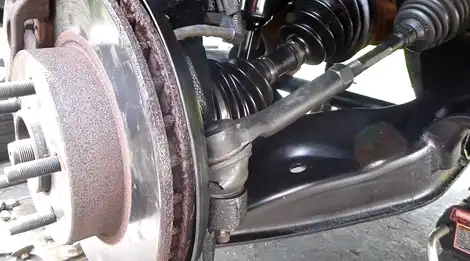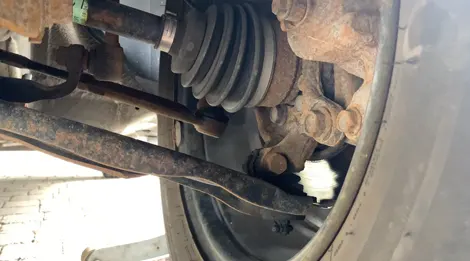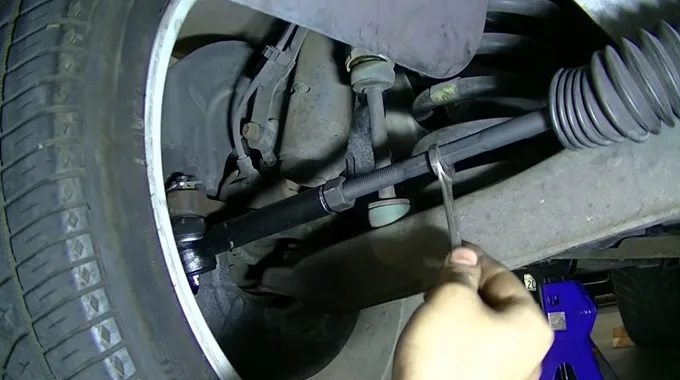Last Updated on April 12, 2023
Tie rods are a vital component of your vehicle’s suspension system. They hold the wheels in place and allow them to pivot, but they also help keep your tires aligned with the frame of your car.
If you notice that one side seems to be lower than the other or if there is significant wear on one wheel, it could be time to adjust your new tie rod. This article will show you how to adjust tie rods and make the necessary adjustments.
Symptoms That Indicate You Need To Adjust Your Tie Rods
Here are some signs that may mean you need to adjust your tie rods:
- One side of your vehicle appears lower than the other
- There is significant wear on one wheel
- Your car pulls to one side when you drive it
- The steering wheel isn’t centered when you’re driving straight
- Your tires squeal when you make a turn
If you notice any of these symptoms, it’s essential to take action and adjust your tie rods. Otherwise, you could end up damaging your suspension or having an accident.
How to Adjust Tie Rods in Your Vehicle?

There are many ways to adjust your tie rods, and the procedure may vary depending on your car. Here is a general overview of how to do it:
To change the tie rod adjustment, you will need:
- A wrench
- A socket set
- A screwdriver
- A hammer (If necessary)
Instructions:
1. Park Your Vehicle Flat:
Before adjusting your tie rods, you need to make sure your vehicle is parked flat. This will ensure that the suspension is neutral and that the wheels are pointing straight ahead.
2. Loosen the Jam Nut:
The jam nut is a locking nut that prevents the tie rod from moving. To adjust the tie rod, you will need to loosen the jam nut.
3. Adjust the Tie Rod:
Once the jam nut is loose, you can adjust the tie rod by turning it clockwise or counterclockwise. To adjust, you will need a wrench or a socket set.
4. Tighten The Jam Nut:
After you’ve adjusted, you need to tighten the jam nut to lock the tie rod in place.
5. Test-drive Your Vehicle:
Once you’ve adjusted the tie rod, it’s essential to test-drive your vehicle to make sure the adjustment was successful. Drive around for a few minutes and pay attention to how the car handles. If everything feels normal, then you’re done!
This is how you can adjust tie rods in your vehicle. If you notice any of the symptoms mentioned earlier, it’s important to take action and make the necessary adjustments.
Common Problems with Tie Rods and How to Fix Them

A few common issues can occur with tie rods, and knowing how to fix them can save you a lot of time and money.
Loose or Damaged Jam Nuts
If the jam nut is loose, it can cause the tie rod to move and become misaligned. To fix this problem, tighten the jam nut. If the jam nut is damaged, you will need to replace it.
Worn Out Tie Rod Ends
If the tie rod ends are worn out, they can cause the steering to feel loose. You will need to replace the tie rod ends to fix this problem.
Damaged or Bent Tie Rods
If the tie rods are damaged or bent, they will need to be replaced.
Misaligned Wheels
If the wheels are misaligned, it can cause the vehicle to pull to one side when you drive it. To fix this problem, you will need to adjust the tie rods.
Knowing how to fix these common problems can save you a lot of time and money. If you’re having trouble with your tie rods, make sure to check for these problems first.
When Should You Replace Your Tie Rods?
If the tie rods are worn out or damaged, they will need to be replaced. Depending on the severity of the damage, you may be able to replace just the tie rod ends. However, if the damage is severe, you may need to replace the entire tie rod.
Replacing your tie rods is an important part of maintaining your vehicle. If you notice any of the symptoms mentioned earlier, it’s important to take action and make the necessary repairs.
How to Choose the Right Tie Rod for Your Vehicle?

There are many different types of tie rods available on the market, and choosing the right one can be confusing. Here are a few things to consider when choosing a tie rod:
- The type of suspension your vehicle has
- The size of the rod ends
- The type of threading
- The material
Once you’ve considered these factors, you can begin to narrow down your choices. If you’re still not sure which tie rod to choose, consult with a mechanic or ask for advice online.
Tips for Maintaining Your Tie Rods
If you want to keep your tie rods in good condition, there are a few tips you can follow:
- Inspect the tie rods regularly and look for any damage.
- If you hit a curb or pothole, check the tie rods for damage.
- When changing your tires, inspect the tie rod ends for wear and tear.
- If you notice any of the symptoms mentioned earlier, take action and make the necessary repairs.
These tips can help you avoid costly repairs and keep your vehicle in good condition.
FAQ’s
Q: What Are Tie Rods?
A: Tie rods are a component of the steering system that connects the steering rack to the spindles. They are responsible for transferring the movement of the steering wheel to the wheels.
Q: What Happens If You Drive With Lousy Tie Rods?
A: If you drive with lousy tie rods, the vehicle may pull to one side, the steering will feel loose, and the wheels may be misaligned. It is essential to take action and make the necessary repairs if you notice any of these symptoms.
Q: Do Bad Tie Rod Ends Make Noise?
A: It is very common for a vehicle to make a knocking or clunking sound when turning at low speeds, which could be a sign of bad tie rods. There is a possibility that the tie rods, as they become loose, may rattle around at the joints and links, resulting in these new sounds you’re hearing.
Q: Do You Need An Alignment After Replacing Ball Joints?
A: No, an alignment is not necessary after replacing ball joints. However, it is always a good idea to have an alignment done when making any large repairs to your vehicle. This will ensure that the wheels are aligned properly and the car drives straight.
Conclusion
If you’ve been experiencing any of the symptoms mentioned earlier, it’s time to take action and make the necessary repairs. The tips we’ve provided should help you avoid costly repairs in the future. Whether your tie rods are worn out or damaged, there is a solution for every problem that just depends on the severity of the damage.
